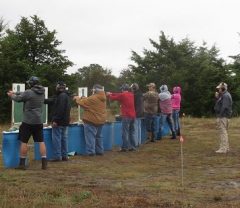Some difficulty encountered by a student recently reminded me how easy it is to overlook the simple things. Dry-firing is one of those (NOTE: do not do this on a rimfire [.22] firearm unless the manufacturer approves it).
Dry-firing is simply
- Verifying the gun is unloaded
- Putting it in condition to fire (cocking or racking)
- With the proper stance and grip, aiming at a spot on the wall, and squeezing the trigger
The goal is to go from the beginning of pressure on the trigger to the break with absolutely no movement of any part of the gun, especially the muzzle, like you are a statue. To make it even better, draw a circle the size of a nickle on a sticky note, stick that on the wall, and stand with the muzzle only 6 inches away from the wall. It should be very easy to tell if there is movement.
After firing, cock or rack as necessary, and repeat. There are four important tricks to help you do this with no movement:
- Identify the amount of take-up (slack) in your trigger; pull back to that point of resistance before starting the mental process of the trigger squeeze, otherwise you will hit a bump.
- Take enough time in the trigger squeeze. For new shooters, there should be at least 1 1/2 seconds between start of pressure and break. It should be gradual and deliberate.
- Consider which part of your finger in pulling the trigger. If it is either the pad or the joint, you may be exerting lateral force on the trigger that causes the gun to move. Find that spot in the middle where those lateral forces cancel out.
- After the break, continue pulling until the trigger touches the frame.
For striker-fired guns that have to be racked every time, sometimes you can just remove the magazine to make that process easier (if you don’t have a magazine disconnect safety). You can also use Snap Caps (dummy cartridges) so the action works normally.
Do this exercise 10 times, rest for a minute, and another 10 times, every day for 30 days. You will be amazed with the results.
